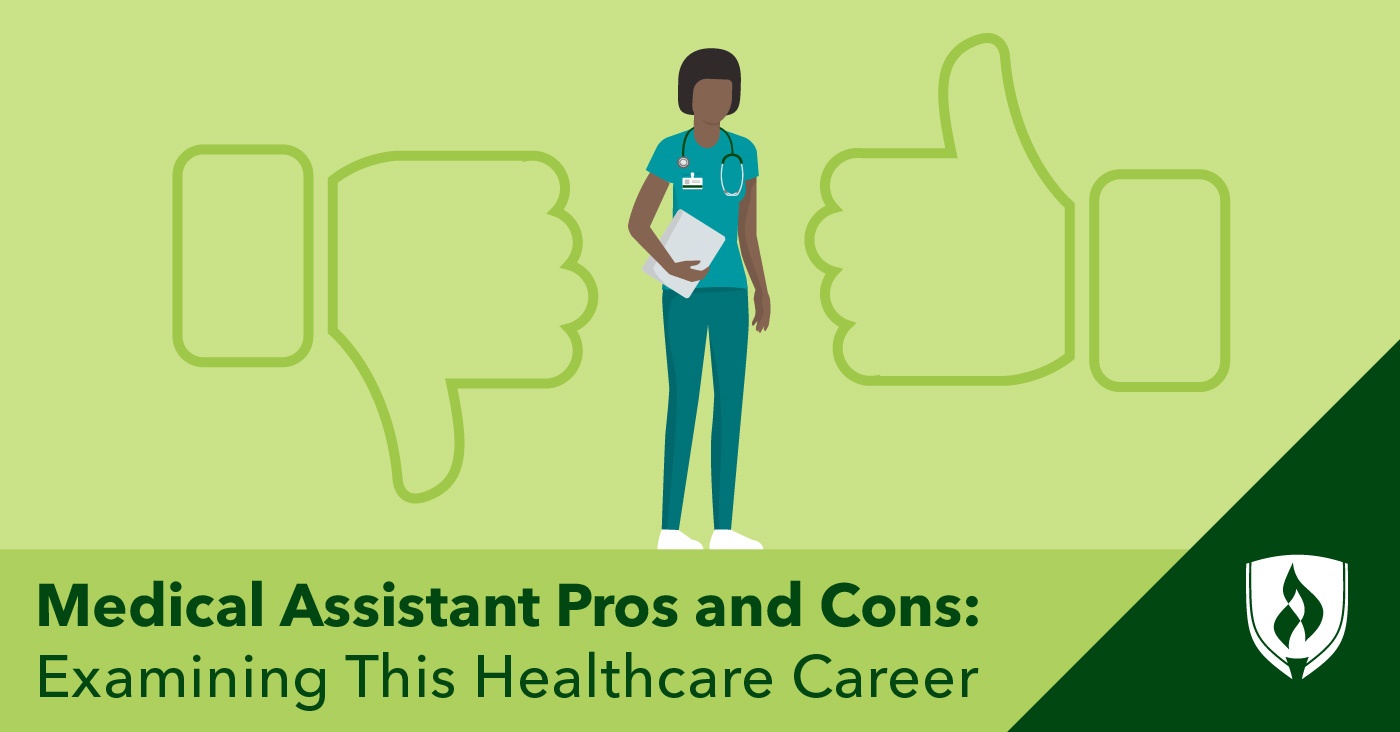Medical Assistant Pros and Cons: Examining This Healthcare Career
By Carrie Mesrobian on 02/21/2022

Healthcare is on everyone’s mind these days, whether it’s related to pandemic developments, changes in insurance regulations or new tech and research changing how we define good health. If you’ve ever been to a clinic, it’s likely you’ve encountered a medical assistant—even if you weren’t aware of the job at the time.
In many healthcare settings, medical assistants are often the first point of contact for patients. Depending on the work environment, they may be answering the clinic’s phones, setting up patient appointments, providing essential forms for you to fill out or updating your records.
But it’s not all administrative work—medical assistants are trained healthcare professionals who also take on direct patient care work like consulting with patients about what’s ailing them, checking vital signs, recording health information, collecting lab specimens and more.
“We focus more on the hands-on—we will be the ones drawing blood. We’re going to be the ones giving all the flu shots, all the hepatitis vaccines, injections and splints,” says Lauren Ramirez, Rasmussen University School of Health Sciences department chair.
Sound like it could be the right role for you? There’s certainly more you’ll want to weigh before zeroing in on a career path. In this article, we’ll take a closer look at some of the potential pros and cons of becoming a medical assistant.
Pros of becoming a medical assistant
What makes a medical assistant career worth your consideration? We highlight some of the top factors to examine.
Strong job outlook
If you’re looking to get your healthcare career started on solid ground, becoming a medical assistant is an excellent option. The Bureau of Labor Statistics projects that employment of medical assistants to grow 18 percent from 2020 to 2030—that’s more than double the national average growth projection.1
Like with many other healthcare careers, the large number of aging members of the baby boomer generation is at the heart of this projected need. While their scope of practice is limited, medical assistants allow healthcare providers to tend to additional patients if they are stretched thin to meet patient demand.
Educational requirements are attainable
For some, the idea of working in healthcare comes crashing down when faced with the reality of what it takes to be academically prepared. The training needed to become a doctor or nurse is intensive—and that’s not a fit for everyone. Medical assisting provides a comparatively manageable pathway for anyone looking to launch a healthcare career.
While it’s true there are no legal education requirements for medical assistants, most employers are seeking candidates who’ve completed some form of post-secondary training. At Rasmussen University, you can complete a Medical Assisting Diploma program in as few as 12 months.2
Active, hands-on work
Medical assistants take on a wide variety of tasks every day. You’ll be on your feet, taking vitals, updating computer records and talking with patients whose needs can vary drastically. Unlike some jobs where your manageable daily routine may quickly turn into a boring slog, there’s a fair amount of variety and unexpected interactions that can keep the work fresh.
“You didn’t know what situation was going to walk in the door,” Ramirez says.
You help care for people
Not every job feels meaningful or personally fulfilling—but patient care roles like medical assisting can certainly be a source for fulfillment. Not everyone who steps into a clinic is excited to be there. So when you have the opportunity to brighten a patient’s day or help ease the nerves of a young patient, it can be a nice reminder of your positive impact.
It’s a geographically versatile role
Whether you prefer the vibrance of big cities or close-knit familiarity of a small town, medical assisting remains a viable option. Medical assistant jobs aren’t really tied to a specific region—you can find them in any location that healthcare providers call home. Anywhere there are clinics, hospitals and patients in need of medical care, there is likely a need for medical assistants.
Cons of becoming a medical assistant
Like with any role, there are aspects of the job that may not appeal to everyone—here are some common issues to consider.
A comparatively limited scope of practice
While medical assistants must do a variety of tasks, their responsibilities are not as extensive as other roles in the healthcare space. Nurses, nurse practitioners and physicians have a more complex set of tools and broader treatment options at their disposal when it comes to influencing patient health outcomes.
There’s potential for evening, weekend and holiday hours
Depending on the type of facility that hires you, it’s possible you may have to work outside of the basic 9-to-5 hours that are common in other jobs. Health concerns don’t tend to follow a set schedule for patients, so that means the clinic or hospital might require evening, weekend and holiday shifts. The silver lining—while not guaranteed—is that employers may pay a premium “shift differential” wage to help offset the negative associated with non-standard hours.
Medical assisting is patient-facing
The flip side of a role that involves caring for people is, well, the people. People who are sick or experiencing a health emergency are understandably stressed—and that’s a recipe for less-than-pleasant interactions. Attending to the needs of patients and answering their questions can be draining, particularly if people skills are not your strong suit. Though healthcare is about helping people, there are other roles in the industry that have less prominent patient-facing requirements.
Is medical assisting in your future?
All careers come with significant pros and cons to consider, and medical assisting is no exception. Now that you know more about some of the good and bad associated with this role, could it be the right fit for you?
If so, you’ll want to check out our article “How to Become a Medical Assistant: The Steps You Can’t Ignore” for more information about the road ahead.
1Bureau of Labor Statistics, U.S. Department of Labor, Occupational Outlook Handbook, [accessed January 2022] https://www.bls.gov/ooh/healthcare/medical-assistants.htm. Information represents national, averaged data for the occupations listed and includes workers at all levels of education and experience. Employment conditions in your area may vary.
2Completion time is dependent on transfer credits accepted and the number of courses completed each term.




